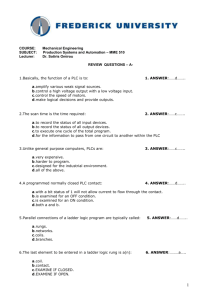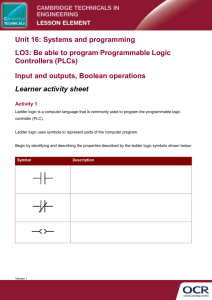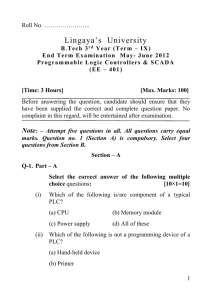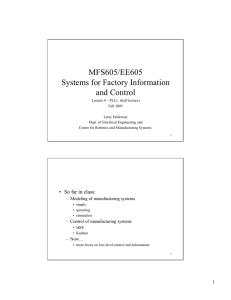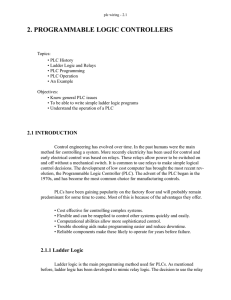discrete control using programmable logic control and
advertisement
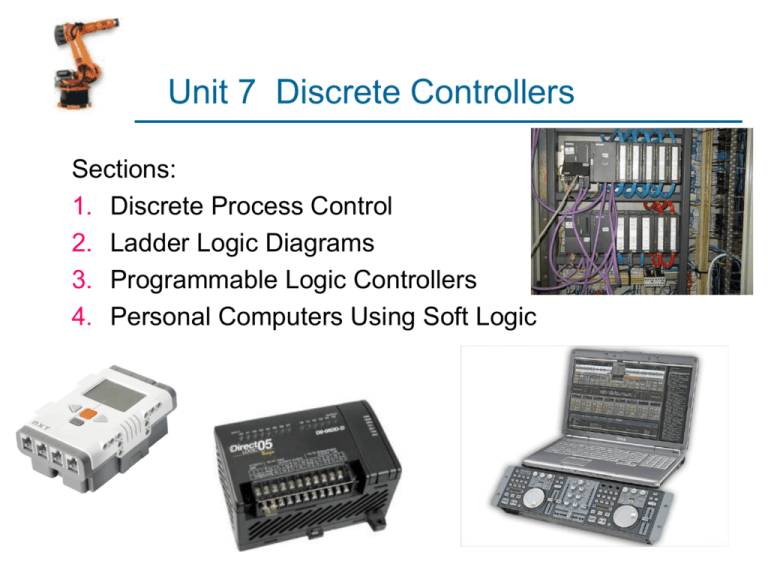
Unit 7 Discrete Controllers Sections: 1. Discrete Process Control 2. Ladder Logic Diagrams 3. Programmable Logic Controllers 4. Personal Computers Using Soft Logic Discrete Process Control Control systems that operate on parameters and variables that change at discrete moments in time or at discrete events, usually binary (0 or 1, off or on, open or closed, etc.) Sensors Limit switch Photo-detector Timer Contact/no contact On/off On/off Actuators Motor Valve Clutch On/off Open/closed Engaged/not engaged Categories of Discrete Control Logic control – event-driven changes Sequencing – time-driven changes Logic Control - a switching system whose output at any moment is determined exclusively by the values of inputs No memory No operating characteristics that depend on time Also called combinational logic control Elements of Logic Control Logic gates: AND – output = 1 if all inputs = 1, zero otherwise OR – output = 1 if any input = 1, zero otherwise NOT – output = 1 if (single) input = 0, and vice versa NAND – combination of AND and NOT NOR – combination of OR and NOT Boolean Algebra & Truth Tables AND function is expressed as Y = X1.X2 OR function is expressed as Y = X1+X2 NOT function is expressed as Y=X1 NAND and NOR Functions Symbols for Logical Gates Example Write the Boolean logic expression for the pushbutton switch system below using the following symbols: X1 = START, X2 = STOP, Y1 = MOTOR, and Y2 = POWER-TO-MOTOR. X2 Y2 Y1 X1 Solution X2 X2 Y2= ( X1 Y1) X2 Y1 X1 Truth Table X1+Y1 Sequencing A switching system that uses internal timing devices to determine when to initiate changes in output variables Outputs are usually generated “open loop” No feedback that control function is executed Sequence of output signals is usually cyclical, as in a high production work cycle The signals occur in the same repeated pattern within each regular cycle Common sequencing devices: Timer – output switches on/off at preset times Counter – counts electrical pulses and stores them Ladder Logic Diagrams A diagram where logic elements are displayed along horizontal rungs 1. Contacts - logical inputs (usually), e.g., limit switches, photo-detector 2. Loads - outputs, e.g., motors, lights, alarms, solenoids 3. Timers - to specify length of delay 4. Counters - to count pulses received Ladder Logic Diagram Example Construct the ladder logic diagrams for (a) the NAND gate and (b) the NOR gate. Solution: X1 (a) NAND C X2 C Y If X1 or X2 remain open then C coil is unexcited and C contact remains closed, therefore Y is on. If X1 and X2 are closed then C coil is excited and C contact is opened and Y is off Solution C X1 (b) NOR X2 C Y If X1 and X2 remain open then C coil is unexcited and C contact remains closed, therefore Y is on. If X1 or X2 are closed then C coil is excited and C contact is opened and Y is off Exercise The production process may only be performed when the operator activates two spring activated safety switches. The switches have to be depressed and held closed together by the operator using both hands. (a) What is the truth table? (b) What is the Boolean logic expression? (c) What is the logic network diagram (in ISO symbol terminology)? (d) What is the ladder logic diagram? Assume X1 and X2 are the first and second switches and Y is the output (a) Truth table for the operation is as follows: Where X1 is first switch, and X2 is second switch, and Y is the output of switch activation. Inputs Solution X1 0 0 1 1 Output Y 0 0 0 1 X2 0 1 0 1 (b) Boolean logic expression for this operation corresponds to the AND logic gate, thus: Y = X1 . X2 (c) The logic network diagram for the operation (in ISO symbol terminology) is as follows: X1 & X2 (d) The ladder logic diagram for the system: X1 X2 Y Y Exercise Create ladder logic diagram for Push Button switch Solution ( X1 Y1) X2 Programmable Logic Controller (PLC) A microcomputer-based controller that uses stored instructions in programmable memory to implement logic, sequencing, timing, counting, and arithmetic functions through digital or analog modules, for controlling machines and processes Components of a PLC Programming Device Processor & Memory I/O Module Outputs Inputs Advantages of PLCs Compared to Relay Control Panels Programming a PLC is easier than wiring a relay control panel PLC can be reprogrammed PLCs take less floor space Greater reliability, easier maintenance PLC can be connected to computer systems (CIM) PLCs can perform a greater variety of control functions Typical PLC Operating Cycle 1. Input scan – inputs are read by processor and stored in memory 2. Program scan – control program is executed Input values stored in memory are used in the control logic calculations to determine values of outputs 3. Output scan – output values are updated to agree with calculated values Time to perform the three steps (scan time) varies between 1 and 25 msec PLC Programming Graphical languages: 1. Ladder logic diagrams – most widely used 2. Function block diagrams – instructions composed of operation blocks that transform input signals 3. Sequential function charts – series of steps and transitions from one state to the next (Europe) Text-based languages: 1. Instruction list - low-level computer language 2. Structured text – high-level computer language PLC Programming Personal Computers Using Soft Logic Sturdy enclosures for plant environment Membrane-type keyboards I/O cards and other hardware to connect to machines and processes Windows for implementing control applications Soft logic software emulating PLCs NXT Controller and Program
